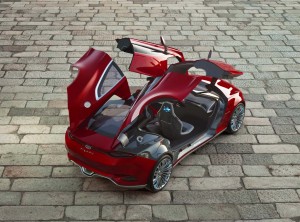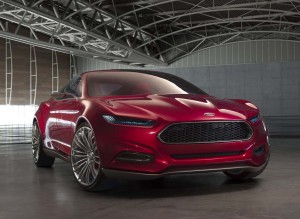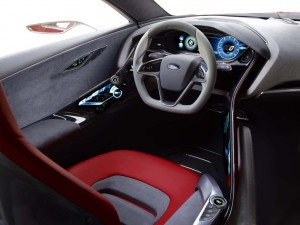Automotive journalists may hate the phrase “design language” due to its prevalence in the industry, but there’s a reason so many designers, executives, and PR people use it. Most automakers are looking to create a unified theme throughout their brand, hence the use of “design” as a “language.” Ford is no different – and the new Evos Concept shows that the maker is switching dialects.
Take a peek at Ford’s consumer Web site and look at all the similarities between the company’s vehicles, particularly those introduced or redesigned in the past few years. Or think for a second about the company’s “One Ford” mission, which aims to streamline product variation across global markets, thus reducing costs.
The Evos Concept will introduce Ford’s newest design language at the upcoming Frankfurt Motor Show. The name, the maker confirms, suggests this is an evolutionary, rather than revolutionary shift. But the impact, if the show car is any indication, will still be significant.
The Evos concept looks like a two-door sports coupe but offers four gull-wing doors. While those doors and other high-zoot concept features likely won’t see production (more on that in a bit), and it’s unclear if the Evos itself will ever roll down an assembly line, the takeaway here is that the concept reveals the basic design cues that most Ford vehicles across the globe will share in the coming years.

Like many new models, the Evos adopts a coupe-like sedan design - but here, all four doors open gull wing-style.
As is common with wild-eyes concepts, the production styling will likely be toned down some. Certainly, the wilder elements won’t be present on the Focus or Fusion. But elements like the big-mouth grille probably will reappear in some form, and while there will be variations from model to model, most will share the same underlying themes.
The Ford Evos is a pretty good preview of what those will be.
Not all Fords will get the Evos treatment—vehicles like the Mustang and F-150, which have their own distinct design vocabularies, won’t—but mainstream models (Fiesta, Fusion, Focus, et al) eventually will.
This approach underscores the maker’s One Ford strategy, which opts for global platforms and products rather than vehicles designed and manufactured for individual markets. That’s not a new idea. The Japanese proved it could work at a mainstream level, the Germans in the luxury world.
The strategy ultimately helps hold down costs — while also making the brand recognizable throughout the world. That doesn’t mean all the cars will look the same, but an American traveling in Europe will probably have an easier time spotting say, a Ford Mondeo in traffic.
Like most concepts, the Evos debuts some futuristic technology. Various interior technologies will use cloud computing – where data such as maps and telephone contacts are stored at a remote location rather than onboard — and the powertrain is of the plug-in hybrid variety. Not to mention those stylish gull-wing doors that turn what looks like a stylish coupe into a four-door sedan.
Further details are scarce, but as a preview of what Ford has in store, we think the future is looking good.


